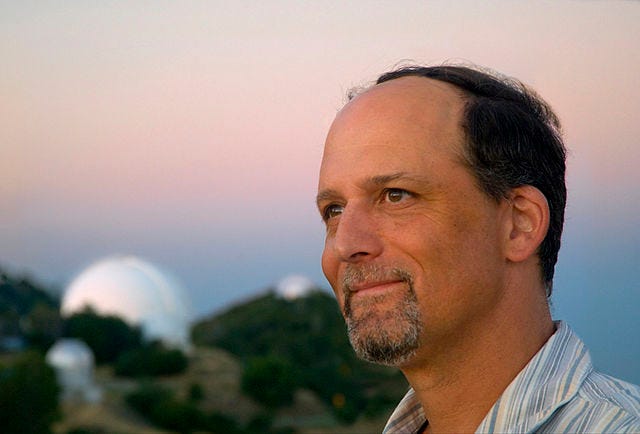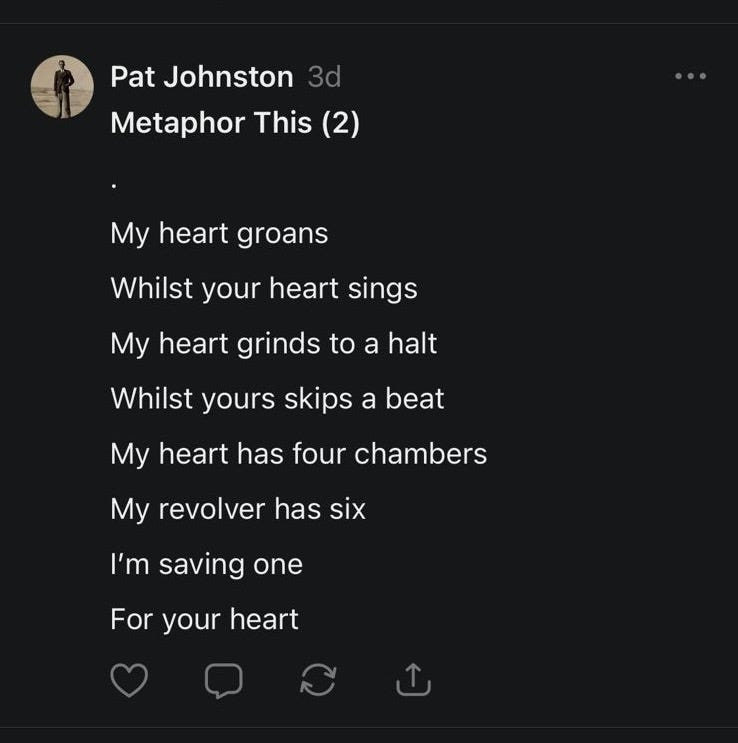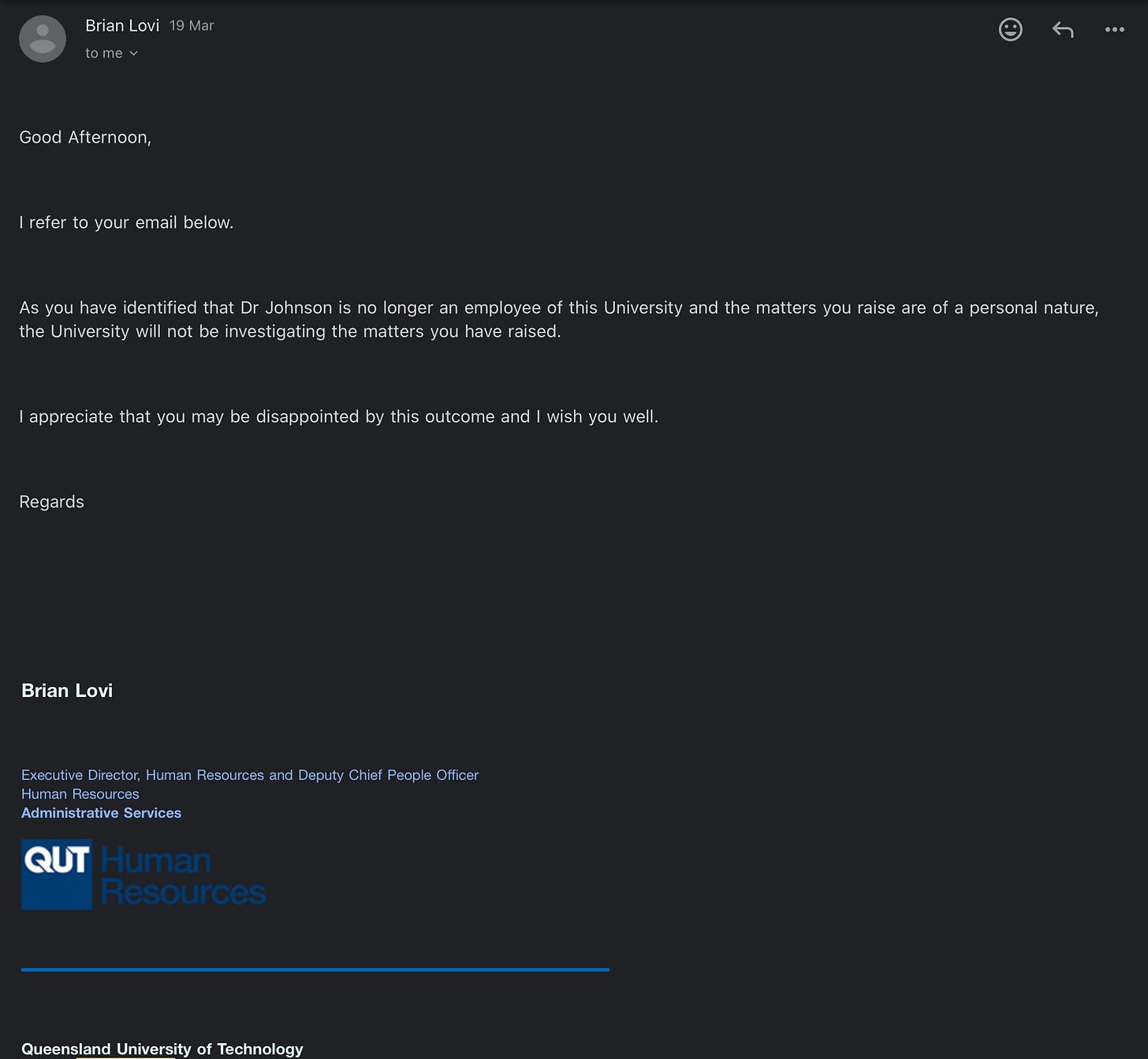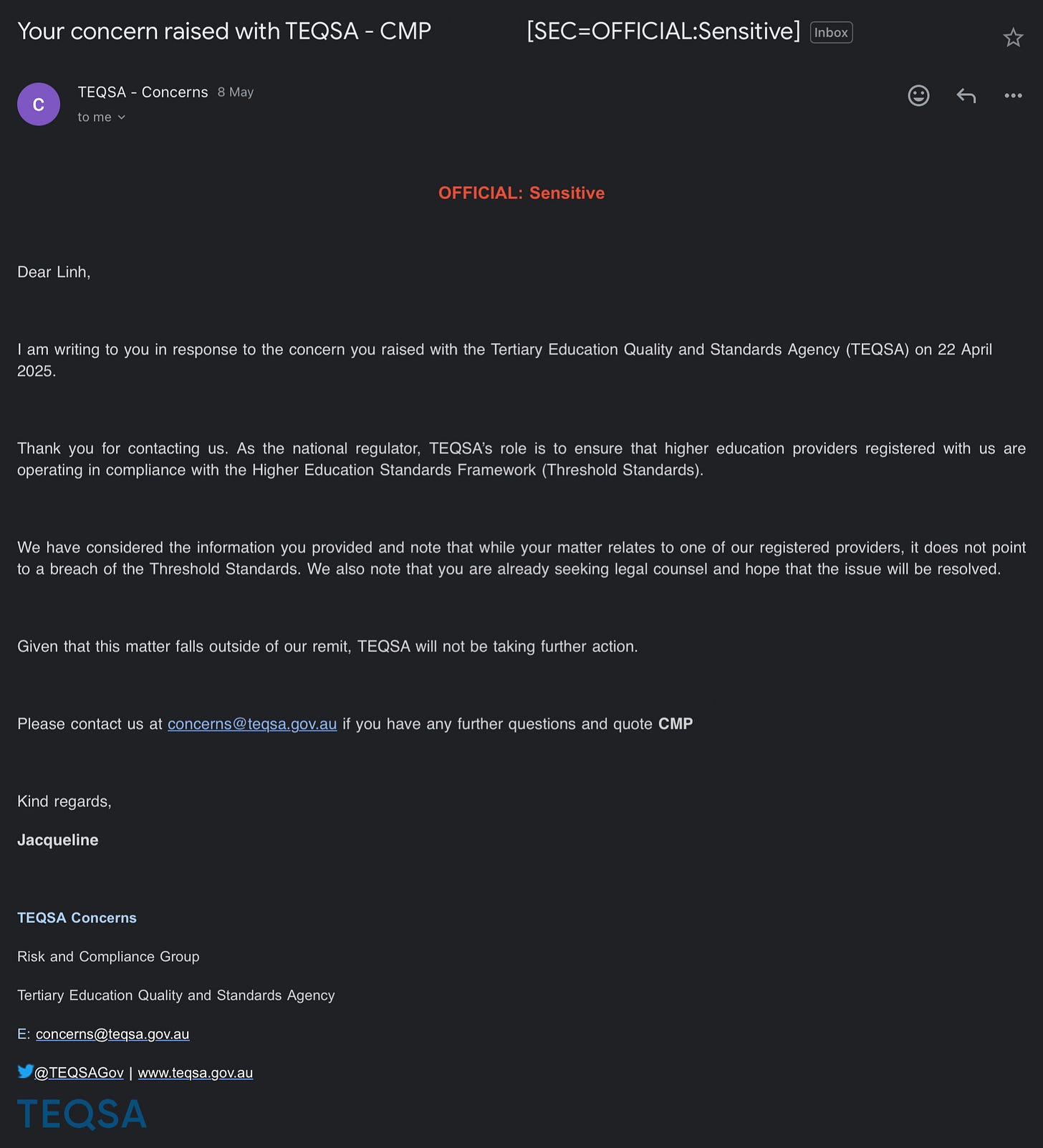Mr. J, a Former Professor Series – Entry 12: Six Years After Ronell – What Academia Still Doesn’t Get
Nimrod Reitman stood in front of the same wall I now face:
A brilliant professor. A silent university. A system with its back turned.
He brought receipts. He was heard. And then — he vanished.
But I won’t.
I am here to write what he could not finish.
It’s that the system watched him vanish — and learned nothing.
I. From Ronell to Johnston Case Study:
Avital Ronell giving a seminar on “Authority” at the European Graduate School, 2007. Photo by lotus5, licensed under CC BY-SA 3.0.
Overview:
In 2018, the Avital Ronell case made headlines across global academia. A renowned professor at NYU, hailed as a postmodernist icon, was accused of prolonged emotional and sexual harassment by her former graduate student, Nimrod Reitman. Despite Ronell’s symbolic power and intellectual influence, NYU was compelled to launch a formal investigation after Reitman filed a Title IX complaint and copied multiple departments and prominent scholars.
Six years later, a quieter case unfolds far from NYU, with a different scale—but hauntingly similar dynamics.
This time, the accused is Patrick James Johnston (Pat Johnston), formerly affiliated with a major Australian university. The reporting party is not a graduate student under supervision, but a younger woman who had a personal and romantic relationship with him. Unlike Reitman, who relied on institutional channels and media coverage, this new case has taken shape through public documentation, forensic reflection, and strategic outreach to over hundreds institutions—led by the survivor herself.
And unlike Ronell, Johnston didn’t have elite allies writing letters on his behalf. He had already been quietly disconnected from his former university. No one defended his genius. No one stepped up to save his title.
Comparative Analysis: From NYU to Queensland — Patterns of Power and Evasion
In this section, I refer to myself in the third person — not to create distance, but to preserve the integrity of comparative analysis.
At first glance, the Ronell–Reitman case and the Johnston–Linh case may seem worlds apart. One unfolded in the heart of global academia — NYU — featuring a tenured professor of immense cultural capital. The other emerged years later, outside traditional supervisory structures, involving a former academic in Australia with no current university post. But when examined side by side, the patterns are alarmingly familiar.
In both cases, the victim occupied a position of structural vulnerability. Nimrod Reitman was a gay, religious male graduate student under direct academic supervision. Linh, by contrast, was a young Asian woman who was not a student of Johnston’s, but a romantic partner significantly younger in age. The context may differ, but the power imbalance — emotional, reputational, and symbolic — was weaponized all the same.
The nature of abuse also mirrored one another in strategic framing. Ronell’s conduct, as documented in over 800 emotionally saturated emails, involved grooming, manipulation, and sexualized language under the guise of academic closeness. Johnston’s actions mirrored these dynamics through grooming masked as romantic closeness, then escalated into coercive threats, reputational attacks, financial pressure, and even sexualised and racialized depictions embedded in public writing.
Linh’s evidence trail included a meticulously maintained forensic series on Substack, supported by screenshots, FMX/EIS reports, and formal submissions to bodies such as QPS and TEQSA.
Institutionally, the Ronell case was handled by NYU’s Title IX and Ethics Office, with oversight from the APA. Her status triggered waves of internal debate and global academic commentary. In Johnston’s case, the original university simply confirmed that he was “no longer employed” and did not pursue further inquiry. Instead, Linh’s documentation was submitted externally — to regulatory bodies, ethics agencies, and academic observers beyond the institution’s reach.
Public tactics also diverged. In Reitman’s case, the internal email trail was leaked to The New York Times, sparking mainstream media coverage. Linh, on the other hand, launched a survivor-led publication series, outlining the escalation timeline with transparency and precision. This digital archive replaced silence with structural narration.
Backlash against the victim took different forms. Reitman was accused by Ronell’s supporters — including some of the most powerful scholars in literature and philosophy — of “not being on her level.” Linh, in contrast, faced fewer elite defenses of the perpetrator due to Johnston’s diminished professional standing, but subtle forms of minimization and silence persisted nonetheless.
Symbolic resistance also emerged in parallel forms. During the Ronell case, some scholars stopped referring to her as “Dr. Ronell” and instead used “Ms. Ronell” in a deliberate gesture of critique. In Linh’s case, the consistent use of “Johnston” in all documentation — rather than “Dr.” — served as a quiet but firm rejection of unearned academic authority.
Finally, both cases featured the same dangerous illusion: that emotional overreach can be framed as affection. Ronell positioned her conduct as mutual intimacy. Johnston too used claims of emotional closeness to excuse boundary violations, only to later threaten reputational harm when the relationship ended.
These aren’t isolated incidents. They’re part of a longer arc of academic power that continues to misread coercion as connection — and continues to protect institutions more than the people they harm.
Six years after Ronell, too many still ask, “Why didn’t you go through the right channels?”
We did. The right channels failed. That’s why we’re writing now — not as victims, but as chroniclers.
Some men write case studies. Others become them.
And maybe, just maybe, Johnston can change the world after all.
Not as a teacher. Not as a scholar. But as a cautionary tale for what happens when power goes unchecked.
⸻
Sources Cited:
I Worked With Avital Ronell. I Believe Her Accuser – Andrea Long Chu, Chronicle of Higher Ed
When the accused is a woman: a #MeToo story’s lessons on gender and power – Anna North, Vox
Harassment and Power – Colleen Flaherty, Inside Higher Ed
Complaint: Reitman v. Ronell and NYU (Full Document) – Scott H. Greenfield, Simple Justice
II. The Geoffrey Marcy Case – When Prestige Delays Justice
Geoffrey Marcy, Professor of Astronomy at UC Berkeley. Image via NASA / Media Telecon. Public domain.
In 2015, the world of astrophysics was rocked by revelations surrounding Geoffrey Marcy, one of UC Berkeley’s most decorated scientists. A pioneer in exoplanet discovery and a frequent name on Nobel shortlists, Marcy was accused of sexual harassment by multiple graduate students across several years. The allegations ranged from unwanted touching to inappropriate advances — often masked under the guise of mentorship.
What made this case emblematic wasn’t just the gravity of the accusations, but how slowly and reluctantly the institution responded.
After an internal investigation concluded that Marcy had indeed violated UC Berkeley’s sexual harassment policy, the university chose not to terminate him. Instead, he received a mere warning — a promise that further misconduct would not be tolerated. This decision was made quietly, without public disclosure, and only became known after external pressure forced transparency.
The academic community did not stay silent. A petition signed by over 2,500 scholars and researchers called for decisive action. The backlash escalated swiftly, and under public scrutiny, Marcy resigned within days.
⸻
Why This Case Still Matters
The Marcy case remains a cautionary tale about how prestige shields misconduct — until the pressure becomes institutionally unbearable.
• It shows that even clear findings of wrongdoing may not trigger adequate consequences unless public visibility raises the cost of silence.
• It also shows how internal investigations, when left unchallenged, can result in soft resolutions that protect reputations rather than victims.
• And perhaps most importantly: it’s not the finding that breaks the system — it’s what the institution chooses to do with it.
⸻
Relevance to the Johnston Case
The echoes between Marcy and Johnston are chilling — though the scale and setting differ.
Johnston, too, operated in a respected university setting, but without the international renown or disciplinary clout Marcy had. This lack of institutional prestige may have actually worked in the survivor’s favor: no one rushed to protect him. No faculty defended his brilliance. No petition sought to preserve his career. In fact, his ties with the institution had quietly ended — and no one seemed interested in reattaching them.
But the survivor, in this case, chose not to wait for institutions to act.
Instead of hoping for silent accountability behind closed doors, she built a public-facing evidentiary narrative, contacted over hundreds organizations across sectors, and documented the psychological and symbolic dimensions of the harm. She didn’t just report misconduct — she mapped its methods.
Whereas Marcy’s survivors were heard only after a leak and a public storm, this case inverts the formula. Here, the pressure was preemptively constructed, not reactionary. It was a strategic narrative. And it left no room for institutional amnesia.
⸻
Sources Cited:
Putting Harassers on Notice - Colleen Flahert, Inside Higher Ed
III. David Sabatini: Genius, Power, and the Limits of Institutional Patience
David M. Sabatini delivering a lecture on the mTOR pathway at the NIH’s Wednesday Afternoon Lecture Series (WALS), 2013. Image via National Institutes of Health. Public domain.
In 2021, the life sciences world watched a seismic fall from grace. David Sabatini, once considered a future Nobel laureate for his pioneering work on mTOR signaling, was forced to resign from the Whitehead Institute and MIT following an internal investigation into allegations of sexual harassment and power abuse. The complainant, a female colleague, alleged that Sabatini had engaged in a sexual relationship that was not only undisclosed but also shaped by significant professional power imbalance.
While Sabatini denied wrongdoing, the institutional response was swift and unprecedented in its breadth. The fallout extended far beyond MIT:
The Howard Hughes Medical Institute (HHMI), one of his major funders, terminated his employment.
He was removed from advisory and editorial positions, including with the New England Journal of Medicine (NEJM).
Harvard Medical School cut ties with him after reviewing the investigation’s findings.
Numerous speaking invitations and consulting roles were rescinded.
In 2022, Sabatini attempted a comeback with a proposed appointment at NYU School of Medicine. The backlash from students and faculty was immediate and intense. Within days, he withdrew his candidacy.
By 2024, Sabatini had quietly re-emerged—first with backing from private funders, and then as a researcher at the Institute of Organic Chemistry and Biochemistry (IOCB) in Prague, while continuing parallel work in Boston. The institutions that once praised his brilliance now remain largely silent.
This case, though different in structure from Ronell’s, underscores a similar pattern: when prestige collides with ethical boundaries, institutions struggle to act decisively—until the public sees it.
What makes the Sabatini case especially instructive is how institutional tolerance can unravel not just from the top, but from the ground up. The pressure didn’t come from elite allies but from internal staff, early-career scientists, and graduate students who refused to normalize misconduct—even if it meant challenging one of the field’s biggest names.
Unlike Ronell, Sabatini didn’t get a letter signed by Judith Butler and Žižek.
Unlike Johnston, he didn’t rely on amateur poetry to reclaim power.
He had only his legacy—and watched it fracture in real time.
⸻
Sources Cited:
HHMI fires prominent biologist for sexual harassment – Meredith Wadman, Science Magazine (Science.org)
Fate and the fallen star – Jenna Reyes, Boston Globe
David Sabatini will not be hired by NYU – Abby Wilson, Washington Square News
NYU med school students, staff walk out to protest potential hiring of David Sabatini – Abby Wilson, Washington Square News
IV. “It took me more emails to call out silence than it took me to build my research proposal” - Hope Jahren and the Cost of Naming Silence
Dr. Hope Jahren, award-winning geobiologist and author of Lab Girl. (Image: U.S. Navy / Jeff Troutman, Public domain)
When the lab looks safe — but isn’t
In Lab Girl, award-winning scientist Hope Jahren described the corrosive effects of institutional silence in academic science. She reflected on how confronting the culture of gender exclusion — even through simple observations — required more effort, emails, and emotional labor than writing her own research proposals.
As she put it: “It took me more emails to call out silence than it took me to build my research proposal.”
Jahren’s case reminds us that speaking up against invisible power structures — even without naming names — demands enormous energy, and often receives institutional friction rather than support.
In that sense, whistleblowing isn’t just about evidence. It’s about confronting a system that rewards politeness over truth.
⸻
Sources Cited:
Lab Girl: one woman’s fight to overcome sexism and save the world – Nicola Davis, The Guardian
V. When Poetry Isn’t Just a Metaphor – Case Studies in Symbolic Threats
Eminem performing at the Concert for Valor in Washington, D.C., November 11, 2014. Photo by EJ Hersom / DoD News Features. Public domain.
In 2000, Eminem released the song “Kim” — a violent lyrical fantasy in which he described murdering his ex-wife in graphic detail. Though framed as “artistic expression,” the song triggered widespread backlash, a police investigation, and performance bans across multiple U.S. states.
Critics argued that the piece — which mimicked a confession — blurred the line between catharsis and psychological abuse. Courts didn’t jail him, but they didn’t dismiss it either. The incident became a case study in media ethics and criminal law classrooms across the U.S.
Now, compare that to a former professor — who once held academic authority, dated the person he later targeted, and used poetic metaphors involving revolvers and “saving a bullet for your heart.” He didn’t perform on stage, but he published publicly. He didn’t rap, but he wrote verses.
Public Note published by Pat Johnston (captured May 15, 2025; archived prior to deletion)
The original post is publicly available here at the time of writing. A full archive with timestamps has been retained for evidentiary purposes.
[Read my related publication: Mr. J, a Former Professor Series – Entry 8: What Makes a Scholar Dangerous here]
And just like Eminem, he can’t hide behind metaphor when the threat is both personalized and public.
Because when a person has a history with you, and then crafts violence in verse — that’s not fiction. That’s symbolic coercion.
—
In both cases — Eminem and “Mr. J,” a former academic — a disturbing pattern emerges: the use of metaphorical language to simulate violence against a former intimate partner.
Eminem’s 2000 track “Kim” painted a vivid, gruesome fantasy of murdering his ex-wife, the mother of his child. Though framed as artistic catharsis, the song prompted police investigation and was banned from being performed in multiple states. His real-life connection to Kim rendered the lyrics more than fictional — they became psychological aggression dressed as performance.
Likewise, “Mr. J” — once a professor, once a partner — published poems containing imagery of revolvers and fatal intent, including the line, “saving one for your heart.” Though not rapped over a beat or staged for a stadium, these writings were public, patterned, and targeted. The prior relationship transforms them from literary metaphor into symbolic threat.
The difference lies in institutional response. Eminem was summoned, questioned, and restricted. “Mr. J” has remained publicly silent, leaning on ambiguity and the presumed sanctity of art. But the similarity is unavoidable:
When there is a real relationship behind the words, metaphors of violence are no longer abstract. They become acts of potential harm — psychological, legal, and reputational.
⸻
Sources Cited:
Inside Eminem’s drug-‘fueled’ recording of ‘Kim’ 25 years ago: He was ‘pissed off – Chuck Arnold, New York Post
VI. Extended Case Study: Consent, Redefined: The Case of Saxon Mullins
When Saxon Mullins reported being raped in a Sydney alleyway at 18, the man was not convicted. Not because the court found her story untrue — but because the law said her lack of consent wasn’t explicit enough.
“I didn’t say yes,” she said. “But I didn’t scream either.”
That legal logic — that absence of a no could imply presence of consent — sent shockwaves across the state. So she spoke out. Wrote. Appeared on national television. And asked the most uncomfortable question in law: if you freeze, does the law assume you agreed?
Her testimony didn’t just haunt headlines. It rewrote legal definitions.
In 2021, after public outcry and systemic review, New South Wales formally redefined the legal meaning of consent — requiring active, ongoing, and enthusiastic agreement.
Not because the system wanted to change. But because one woman refused to let silence write the law.
⸻
Sources Cited:
I Am That Girl – Louise Milligan, ABC Four Corners
Changing affirmative consent laws felt like the fight of a lifetime. So what now? – Saxon Mullins, The Guardian
NSW passes ‘common sense’ affirmative consent bill after advocacy work of Saxon Mullins, SBS Australia
VII. Extended Case Study: Before Brittany, There Was Grace: Speaking When the Law Said “Be Silent”
In 2021, Grace Tame became Australian of the Year — not because she stayed silent, but because she refused to.
As a teenager, she was groomed and abused by her school teacher. Yet under Tasmania’s “gag laws,” she wasn’t legally allowed to speak publicly about her experience — even after the perpetrator was convicted. The law protected his privacy, not her truth.
So she fought back. She went public. She exposed not only the man, but the law that enabled him.
Her voice didn’t just break silence. It broke policy. It forced Tasmania to overturn its suppression laws. It forced a nation to ask: who benefits when victims are silenced by statute?
And when she later stared down the Prime Minister in a televised event — refusing to play nice while institutions stayed complicit — she reminded the country that politeness is no substitute for justice.
⸻
Sources Cited:
Grace Tame – Advocate for survivors of sexual assault – Australian of the Year 2021
Tasmanian sexual assault survivor Grace Tame named 2021 Australian of the Year – Elias Visontay and Mostafa Rachwani, The Guardian
VIII. Extended Case Study – Brittany Higgins vs. Bruce Lehrmann: When Silence Breaks the System
In March 2019, Brittany Higgins, then a junior staffer for Australia’s Defence Minister Linda Reynolds, alleged that she was raped by colleague Bruce Lehrmann inside the ministerial office at Parliament House. Initially, the incident was handled internally, with Higgins feeling unsupported and fearing for her career. It wasn’t until February 2021 that she publicly disclosed her experience, sparking national outrage and a reckoning within Australian politics.
Lehrmann was charged, but his 2022 criminal trial was aborted due to juror misconduct. Subsequently, the prosecution dropped the case, citing concerns over Higgins’ mental health. In a 2024 civil defamation case that Lehrmann filed against Network Ten and journalist Lisa Wilkinson, Justice Michael Lee found, on the balance of probabilities, that Lehrmann had raped Higgins, describing his actions as “hellbent on having sex” without regard for consent .
The fallout led to significant reforms in Parliament House, including the establishment of the Parliamentary Workplace Support Service and stricter codes of conduct for MPs . Higgins received a compensation payout of approximately $2.3 million from the federal government for the mishandling of her case .
This case underscores the power of media and public discourse in holding institutions accountable, especially when internal mechanisms fail. It also highlights the personal toll on survivors who choose to speak out, often facing intense scrutiny and legal battles.
⸻
Key Dynamics:
Location of assault: The Australian Parliament – a symbol of public safety.
Internal dismissal: Her report was brushed off. She was pressured to stay silent and eventually resigned.
Delayed justice: The criminal trial collapsed due to a jury breach. But public pressure never faded.
Civil resolution: Higgins later won over $2 million AUD in compensation from the federal government, acknowledging institutional failure.
⸻
What Made This Case a National Reckoning?
It wasn’t just about the perpetrator.
Higgins named everyone who failed her — the Defence Minister, the Chief of Staff, the toxic work culture. She shifted the spotlight from one man to an entire system.She waited for momentum.
Higgins didn’t speak out immediately. She spoke in 2021, when Australia’s #MeToo was gaining traction — via a trusted media outlet (Channel 10), not random posts.She changed legal lanes.
When criminal prosecution collapsed, she pivoted to civil litigation — targeting government accountability instead of chasing a punitive outcome against one man.It triggered reforms.
The case led to:A Human Rights Commission audit of Parliament
A whistleblower hotline
Career damage for multiple politicians, not just the accused.
⸻
What I’ve Learned — and Applied
The Higgins case wasn’t just about a single assault. It was about how silence, when normalized, corrodes every layer of institutional responsibility. For those of us confronting systemic neglect — in universities, in regulatory bodies, or in professional fields — her story became more than just a headline. It became a framework.
Here’s what I’ve learned — and actively put into practice:
Systems don’t collapse loudly — they decay in silence.
Like Higgins, I’ve tracked not only individual misconduct but the repeated silences of institutions that knew, received reports, and chose not to act.Timing is part of the strategy.
I chose to speak publicly only after documenting enough evidence, analyzing institutional pathways, and watching how related cases unfolded nationally. Strategic silence before publication was not fear — it was preparation.This isn’t about private conflict — it’s about public duty.
What happened to me isn’t reducible to a failed relationship. It’s a structural failure of duty of care — by regulators, publishers, and academic authorities who were informed, yet disengaged.The fight is larger than the man.
My reports weren’t sent to shame a former partner. They were sent to ethics boards, ombudsman offices, universities, and national regulators — because the real threat isn’t just a person, but a system that lets him operate unchecked.
⸻
Sources Cited:
A cultural reckoning’: how an allegation of rape in Australia’s parliament sparked a firestorm – Elias Visontay, The Guardian
Parliament rape claim was true, judge rules in case that gripped Australia – Tory Shepherd, The Guardian
⸻
When Silence Becomes Complicity: A Note to QUT
I have raised concerns with Queensland University of Technology (QUT) regarding the professional misconduct of Patrick James Johnston (Pat Johnston) — a former academic staff member whose actions, including coercive messaging, reputational threats, and the misuse of academic affiliation, began while he was still publicly representing QUT.
To date, the university has framed this issue as a “personal matter.” That framing is not just inadequate — it’s institutionally dangerous. It disregards the ongoing reputational weight that comes with an academic title, and it fails to account for the duty of care owed to individuals impacted by those who benefit from QUT’s institutional credibility.
Email response from Brian Lovi, Executive Director – Human Resources, Queensland University of Technology (QUT), dated March 19, 2025.
It’s important to be clear: the misconduct did not occur in a vacuum. It evolved while Johnston was using his academic status to build trust, assert moral authority, and eventually to deflect accountability. The fact that these acts escalated into racialized targeting, public coercion, and reputational manipulation only underscores the risks of institutional inaction.
I had notified QUT well before the situation intensified. There was a window of opportunity for responsible intervention. Instead, the university’s silence — then and now — signals a dangerous precedent: that once a staff member exits the payroll, the institution absolves itself of responsibility, regardless of how their legacy is weaponized.
And yet QUT made no assurance to those affected. No ethical audit.
This matters — not because of optics, but because reputational authority is not bound by contract dates. If QUT lent him credibility, then it shares in the burden of ensuring that credibility was not abused.
⸻
This case was formally submitted to two oversight bodies: ARIC and TEQSA.
ARIC responded with clarity, professionalism, and a constructive tone — acknowledging the risk context and offering procedural guidance.
TEQSA, by contrast, marked the matter as official: sensitive, but ultimately declined to act, citing jurisdictional limitations and the existence of ongoing legal advice.
The contrast is telling. When one regulator engages respectfully while another withdraws under the cover of “remit,” the silence becomes less about caution — and more about structure.
It raises an institutional question that sits well beyond my case:
When reputational harm is acknowledged but not addressed, who exactly is the system protecting — and who is it built to exclude?
If a man weaponizes his title, and the institution remains silent, who exactly is being protected?
Email response from TEQSA’s Risk and Compliance Group, 8 May 2025.
In response to a formal complaint, the agency acknowledged receipt and reviewed the matter, but declined to intervene — citing jurisdictional limitations and the absence of a direct breach of Threshold Standards. The representative, signing only as “Jacqueline,” classified the matter as Official: Sensitive but stated that it fell outside TEQSA’s remit.
Case ID withheld for privacy — available upon formal request by media or oversight body.
⸻
TEQSA may have declined to act, but regulatory accountability in Australia does not begin or end with a single agency. The Office of the Commonwealth Ombudsman monitors agencies like TEQSA and may review cases where procedural responsibilities are in question.
The Senate Education and Employment References Committee — which has previously investigated misconduct in higher education — accepts whistleblower submissions related to systemic failure or institutional negligence.
If the harm involves academic publishing, the Committee on Publication Ethics (COPE) can be approached to assess ethical breaches in editorial or scholarly conduct.
And where formal institutions stay silent, there remain avenues for public scrutiny. Independent media — including The Guardian Australia, ABC News, Crikey, and The Saturday Paper — have a documented history of exposing academic coercion and reputational abuse when regulatory bodies fall short.
In short: when one door closes, institutional accountability doesn’t vanish. It simply shifts to a broader public record.
Update (June 10, 2025): Counter-Takedown Filed — Fair Use & Survivor-Led Documentation
On June 9, I received a formal DMCA notice from Google informing me that Patrick Johnston had submitted a copyright takedown request targeting my publicly accessible survivor evidence folders documentation already submitted to QPS as part of police evidence.
This content, previously submitted to law enforcement in the context of unwanted contact and coercive behavior, cannot retroactively be reframed as protected intellectual property for the purpose of silencing survivor documentation.
Any takedown request targeting such material constitutes a strategic misuse of copyright law, not a legitimate rights claim.
These files were published strictly under academic Fair Use and Fair Dealing protections, as part of an ethics-based documentation series. This takedown is not a valid copyright dispute, but a coercive response to institutional criticism.
Attempts to assert copyright over police-submitted evidence constitute a serious ethical and potentially legal breach. Such actions may be interpreted as obstruction of justice and retaliation against protected reporting
This is not copyright protection. This is reputational panic, disguised as a takedown notice.
The content was non-commercial, already submitted to Queensland Police (QPS) and regulators under official case IDs. Its removal constitutes an attempt to suppress documented harms rather than enforce legitimate rights. Misusing copyright mechanisms in this manner may qualify as a form of strategic litigation against public participation (SLAPP).
My publication falls squarely within the thresholds of:
Australian Copyright Act 1968 – Sections 41 & 42 (Fair Dealing)
U.S. Copyright Law – §107 (Fair Use)
International norms protecting public interest commentary and trauma documentation.
I have submitted a formal counter-notice. As per standard procedure, Google has forwarded the takedown request to the Lumen Database, where it is now publicly visible as part of platform transparency archives.
View takedown request on Lumen
If harassment persists, I reserve the right to escalate this matter to ethics boards, international legal monitors, and public interest watchdogs tracking strategic censorship and retaliatory misuse of institutional tools.
Any misuse of personal information obtained via counter-notice or takedown responses will be treated as further coercive harassment and may be reported to law enforcement under digital harm and privacy abuse frameworks.
No individual has the right to suppress survivor-led documentation solely on the basis of personal discomfort — especially when such material pertains to evidence already submitted to law enforcement.
Note on Naming
The subject of these verses is identified by name due to the severity and public nature of the threats made during that period.
Naming is not intended to humiliate, but to preserve the integrity of the record and reflect the seriousness of the documented behavior. Selective rebuttal is not accountability.
Additional individuals referenced in this entry — including Avital Ronell, Nimrod Reitman, Geoffrey Marcy, David Sabatini, Hope Jahren, Eminem, Saxon Mullins, Grace Tame, Brittany Higgins, and Bruce Lehrmann — appear in connection with publicly documented cases or symbolic precedents. Their names are cited not for sensationalism, but to anchor this analysis in real-world ethical, legal, and cultural frameworks across disciplines and eras.
This entry is published in good faith, based on firsthand documentation, institutional correspondence, and public archives. It is intended for reflective analysis and public-interest recordkeeping, not personal retaliation or defamation.
Full evidence archive submitted to QPS, TEQSA, AHRC, and Ethics Australia: View here.
Professional or legal clarification is welcome via appropriate institutional channels.
Sources:
I Worked With Avital Ronell. I Believe Her Accuser – Andrea Long Chu, Chronicle of Higher Ed
When the accused is a woman: a #MeToo story’s lessons on gender and power – Anna North, Vox
Harassment and Power – Colleen Flaherty, Inside Higher Ed
Complaint: Reitman v. Ronell and NYU (Full Document) – Scott H. Greenfield, Simple Justice
Putting Harassers on Notice - Colleen Flahert, Inside Higher Ed
HHMI fires prominent biologist for sexual harassment - Meredith Wadman, Science Magazine (Science.org)
Fate and the fallen star - Jenna Reyes, Boston Globe
David Sabatini will not be hired by NYU, Abby Wilson, Washington Square News
NYU med school students, staff walk out to protest potential hiring of David Sabatini, Abby Wilson, Washington Square News
Lab Girl: one woman’s fight to overcome sexism and save the world – Nicola Davis, The Guủadian
Inside Eminem’s drug-‘fueled’ recording of ‘Kim’ 25 years ago: He was ‘pissed off - Chuck Arnold, New York Post
I Am That Girl – Louise Milligan, ABC Four Corners
Changing affirmative consent laws felt like the fight of a lifetime. So what now? – Saxon Mullins, The Guardian
NSW passes ‘common sense’ affirmative consent bill after advocacy work of Saxon Mullins, SBS Australia
Grace Tame – Advocate for survivors of sexual assault – Australian of the Year 2021
Tasmanian sexual assault survivor Grace Tame named 2021 Australian of the Year – Elias Visontay and Mostafa Rachwani, The Guardian
A cultural reckoning’: how an allegation of rape in Australia’s parliament sparked a firestorm – Elias Visontay, The Guardian
Parliament rape claim was true, judge rules in case that gripped Australia – Tory Shepherd, The Gủuadian
Image Credits:
Cover photo by Pat Whelen on Unsplash
Avital Ronell giving a seminar on “Authority” at the European Graduate School, 2007. Photo by lotus5, licensed under CC BY-SA 3.0.
Geoffrey Marcy, Professor of Astronomy at UC Berkeley. Image via NASA / Media Telecon. Public domain.
David M. Sabatini delivering a lecture on the mTOR pathway at the NIH’s Wednesday Afternoon Lecture Series (WALS), 2013. Image via National Institutes of Health. Public domain.
Dr. Hope Jahren, award-winning geobiologist and author of Lab Girl. (Image: U.S. Navy / Jeff Troutman, Public domain)
Eminem performing at the Concert for Valor in Washington, D.C., November 11, 2014. Photo by EJ Hersom / DoD News Features. Public domain.
Read the full series
- Entry 1: The Man Who Taught Me Ethics by Failing All of Them
- Entry 2: The Disappearance of the Public Poet
- Entry 3: The Hanging Tree Case Study
- Entry 4: Hidden Like Accountability
- Entry 5: The Collapse of Assumptions
- Entry 6: The Ethics of a Tinder Bio
- Entry 7: How He Ate Told Me Everything
- Entry 8: What Makes a Scholar Dangerous
- Entry 9: Fragment of Life, Fragment of Accountability
- Entry 10: Anatomy of Disappointment
- Entry 11: Legal Defense Challenges: A Framing Statement
- Entry 12: Six Years After Ronell – What Academia Still Doesn’t Get (you are here)
- Entry 13: QUT and The Man Who Raped Me
- Entry 14: Why Sarcasm Toward Institutions Can Backfire
- Entry 15: P*ssy or Toxic Masculinity?
- Entry 16: Who is Your Favorite Comedian?
- Entry 17: And What is Your Favorite Song?
- Entry 18: Grant Proposal — Narrative Ethics as Survivor-Led Forensics
- Entry 19: The Coward Behind the Clone
- Entry 20: [URGENT HIRE] CRISIS COMMUNICATIONS SPECIALIST
- Entry 21: [URGENT] Legal Counsel Needed for Complex Reputation Rehabilitation
- Entry 22: YOU’RE AN ABUSER. STOP CONTACTING ME
- Entry 23: Seeking Counsel for a Fallen Academic
- Entry 24: Internal Legal-PR Briefing
- Entry 25: For Journalists – Legal & Ethical Clearance Summary
- Entry 26: Symbolic Prostitution, Transactional Intimacy, or Just a “Loan”?
- Entry 28: Why He Simply Cannot Shut Up
- Entry 29: Forensic Commentary on “LARGE Language Muddle”
- Entry 30: Don’t Just Threaten My Future. Because I’m Going To Archive Your Present
- Entry 31: Open Letter to the Person Who Tried to Break Me with Defamation
- Entry 32: Defamation, Harassment, Doxxing Class 101
- Entry 33: Confidential Crisis Recovery Proposal
- Entry 34: Forensic Behavioral-Somatic Report
- Entry 35: Forensic Commentary on the Tattoos
- Entry 36: QUT and the Abuser They Once Had
- Entry 38: When Poetry Becomes Revenge Porn
- Entry 40: A Man Built for Applause, Not Accountability
- Entry 41: Neurobehavioral Addendum
- Entry 43: Why Does It Sound Like a War Metaphor?
- Entry 44: Forensic Commentary on Racialized and Fetishizing Language in “Hidden Like Rice”
- Entry 45: Public Misuse of Former Academic Affiliation
- Entry 46: The Two Things That Didn’t Leave a Bad Impression
- Reflection: The Miscalculation
(More entries coming soon)
→ [Back to Start: Introducing Mr. J, a Former Professor Series]
© 2025 Linh Ng. All rights reserved.
This publication is intended for educational and reflective purposes only.
Sharing the original link is welcomed and encouraged.
Please do not reproduce, redistribute, or translate this content — in whole or in part — without written permission.
This piece reflects both lived experience and critical analysis. It is not meant to be detached from its author or reframed without context.
Misuse or decontextualization may lead to formal clarification or takedown requests.
This work has been reviewed and quietly followed by scholars, educators, and ethics professionals across multiple sectors.
If your institution is engaging in critical discourse around narrative justice, symbolic coercion, or representational ethics, feel free to connect via Substack DMs or formal channels.
A regulatory case regarding this matter has already been classified under a protected status within national education integrity systems.
Should any reputational countermeasures or distortions arise, I reserve the right to publish the documented timeline, behavioral patterns, and contextual metadata.
All relevant documentation has been submitted through formal legal and regulatory pathways.












